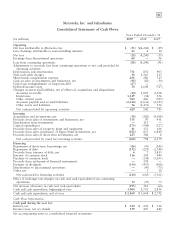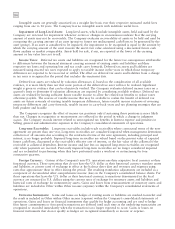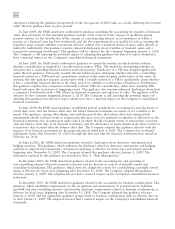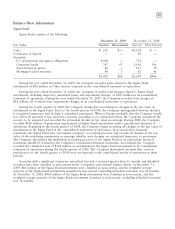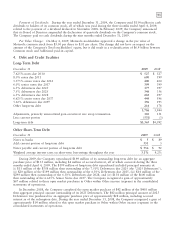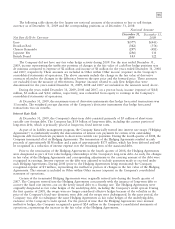Motorola 2009 Annual Report Download - page 94
Download and view the complete annual report
Please find page 94 of the 2009 Motorola annual report below. You can navigate through the pages in the report by either clicking on the pages listed below, or by using the keyword search tool below to find specific information within the annual report.
86
anticipates adopting the guidance prospectively in the first quarter of 2010 and, as a result, deferring less revenue
under the new guidance than in prior periods.
In June 2009, the FASB issued new authoritative guidance amending the accounting for transfers of financial
assets. Key provisions of this amended guidance include (i) the removal of the concept of qualifying special
purpose entities, (ii) the introduction of the concept of a participating interest, in circumstances in which a
portion of a financial asset has been transferred, and (iii) the requirement that to qualify for sale accounting the
transferor must evaluate whether it maintains effective control over transferred financial assets either directly or
indirectly. Additionally, this guidance requires enhanced disclosures about transfers of financial assets and a
transferor’s continuing involvement. This guidance will be effective for the Company beginning January 1, 2010.
The Company is still assessing the potential impact of adopting this guidance but does not expect adoption to
have a material impact on the Company’s consolidated financial statements.
In June 2009, the FASB issued authoritative guidance to amend the manner in which entities evaluate
whether consolidation is required for variable interest entities (VIEs). The model for determining whether an
enterprise has a controlling financial interest and is the primary beneficiary of a VIE has changed significantly
under the new guidance. Previously, variable interest holders had to determine whether they had a controlling
financial interest in a VIE based on a quantitative analysis of the expected gains and/or losses of the entity. In
contrast, the new guidance requires an enterprise with a variable interest in a VIE to qualitatively assess whether
it has a controlling financial interest in the entity and, if so, whether it is the primary beneficiary. Furthermore,
this guidance requires that companies continually evaluate VIEs for consolidation, rather than assessing VIEs
based only upon the occurrence of triggering events. This guidance also requires enhanced disclosures about how
a company’s involvement with a VIE affects its financial statements and exposure to risks. The guidance will be
effective for the Company beginning January 1, 2010. The Company is still assessing the potential impact of
adopting this guidance but does not expect adoption to have a material impact on the Company’s consolidated
financial statements.
In May 2009, the FASB issued guidance establishing general standards for accounting for and disclosure of
events that occur after the balance sheet date but before financial statements are issued or are available to be
issued. This guidance, among other things, sets forth the period after the balance sheet date during which
management should evaluate events or transactions that may occur for potential recognition or disclosure in the
financial statements, the circumstances under which an entity should recognize events or transactions occurring
after the balance sheet date in its financial statements, and the disclosures an entity should make about events or
transactions that occurred after the balance sheet date. The Company adopted this guidance effective with the
issuance of its financial statements for the quarterly period ended July 4, 2009. The Company has evaluated
subsequent events after December 31, 2009, through the date and time the financial statements were issued on
February 16, 2010.
In March 2008, the FASB issued new guidance related to disclosures about derivative instruments and
hedging activities. This guidance, which enhances the disclosure related to derivative instruments and hedging
activities to improve the transparency of financial reporting, is effective for fiscal years and interim periods
beginning after November 15, 2008. The Company adopted this guidance effective January 1, 2009. The
disclosures required by this guidance are included in Note 5, ‘‘Risk Management.’’
In December 2007, the FASB issued new guidance related to the accounting for and reporting of
non-controlling interests (formerly minority interests) and for the loss of control of partially owned and
consolidated subsidiaries. This guidance, which does not change the criteria for consolidating a partially owned
entity, is effective for fiscal years beginning after December 15, 2008. The Company adopted this guidance
effective January 1, 2009. The adoption has not had a material impact on the Company’s consolidated financial
statements.
In December 2007, the FASB issued new guidance related to the accounting for business combinations. This
guidance, which establishes requirements for the recognition and measurement of acquired assets, liabilities,
goodwill and non-controlling interests and provides disclosure requirements related to business combinations, is
effective for fiscal years beginning after December 15, 2008. The Company adopted this guidance effective
January 1, 2009, and has applied the guidance prospectively to business combinations with an effective date on
or after January 1, 2009. The adoption has not had a material impact on the Company’s consolidated financial
statements.







